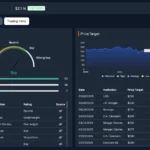The Ultimate Guide to Link in Bio Tools: Maximizing Your Social Media Presence in 2025

In today’s fragmented digital landscape, content creators, influencers, brands, and businesses face a common challenge: the inability to share multiple links directly from social media profiles. With most platforms limiting users to a single “link in bio,” finding the right solution to maximize this valuable real estate has become essential for driving traffic, conversions, and engagement across your online presence.
This comprehensive guide explores the best link in bio tools available in 2025, comparing their features, pricing, analytics capabilities, and ideal use cases to help you select the perfect solution for your specific needs.
Why Link in Bio Tools Have Become Essential
Social media platforms like Instagram, TikTok, and Twitter (now X) have revolutionized how we connect with audiences, but they’ve also created limitations. Most notably, these platforms restrict users to a single external link in their profile, creating what marketers call the “link in bio bottleneck.”
This limitation presents significant challenges:
- You can’t simultaneously promote your website, latest content, products, and services
- Updating links manually for each new promotion becomes time-consuming
- Tracking which links drive the most traffic and conversions is difficult
- Creating a cohesive cross-platform experience requires multiple tools
Link in bio tools solve these problems by creating a centralized landing page that houses multiple links, effectively transforming your single bio link into a dynamic hub for all your content and offerings.
“The average social media user has 8.4 different platforms they actively use,” explains digital marketing strategist Maya Rodriguez. “Link in bio tools bridge the gap between these fragmented audiences, creating a consistent experience regardless of where followers discover you.”
Top Link in Bio Tools for 2025
1. Linktree: The Industry Pioneer
Best for: All-around use across most industries
As the original link in bio solution, Linktree has maintained its position as the market leader by continuously evolving its feature set and keeping its interface remarkably user-friendly.
Key Features:
- Clean, minimalist design with customizable themes
- Analytics tracking views, clicks, and geographic data
- Commerce links for product sales and monetization
- Form collection for lead generation
- Scheduling links to appear at specific times
- Mobile app for on-the-go management
Pricing:
- Free plan: Basic features with Linktree branding
- Starter ($5/month): Custom themes and limited analytics
- Pro ($9/month): Priority support, advanced analytics, scheduling
- Premium ($24/month): Enterprise features, advanced integrations
Standout Capability:
Linktree excels in its balance between simplicity and functionality. Its commerce integrations allow creators to sell products, accept tips, and collect payments directly from their Linktree page without requiring visitors to navigate to another platform.
“What I appreciate about Linktree is how it grows with you,” says content creator Jamie Chen. “I started with the free version as a hobby blogger, and as my audience grew, I upgraded for better analytics and monetization features without having to migrate to a new platform.”
2. Beacons: The All-in-One Creator Hub
Best for: Content creators focusing on monetization
Beacons has rapidly gained popularity by positioning itself as more than just a link in bio tool—it’s a comprehensive platform for creator monetization.
Key Features:
- Customizable landing pages with multimedia support
- Built-in storefront for digital products
- Request form for brand partnerships
- Tip jar and fan funding options
- Email collection and newsletter integration
- Advanced analytics dashboard
Pricing:
- Free plan: Basic features with limited customization
- Pro ($10/month): Advanced customization and analytics
- Advanced ($15/month): Priority features and monetization tools
Standout Capability:
Beacons’ integrated monetization tools set it apart. Creators can sell digital products, accept tips, manage brand deals, and build their email list—all from a single platform without requiring complex integrations or technical knowledge.
“Beacons turned my link in bio from a simple directory into a legitimate revenue stream,” reports photographer Alex Martinez. “The ability to sell presets directly from my social bio has increased my monthly income by 40% with virtually no additional effort.”
3. Koji: The Interactive Experience Platform
Best for: Creators seeking interactive engagement tools
Koji takes link in bio functionality to the next level with interactive “mini-apps” that transform passive visitors into active participants.
Key Features:
- App store with hundreds of mini-applications
- Interactive elements like polls, quizzes, and games
- Monetization through tips, products, and premium content
- Customizable themes and layouts
- Analytics for engagement metrics
- Developer platform for custom mini-apps
Pricing:
- Free plan: Basic features with Koji branding
- Pro ($12/month): Advanced features, analytics, and premium mini-apps
Standout Capability:
Koji’s mini-app ecosystem creates unique interactive experiences that keep visitors engaged far longer than traditional link pages. From personality quizzes to playable games, these interactive elements transform passive scrolling into active participation.
“Our engagement time increased by 340% after switching to Koji,” notes gaming influencer Riley Jackson. “Instead of just clicking a link and leaving, followers spend an average of 3.5 minutes interacting with our polls and mini-games before navigating to our main content.”
4. Bio.fm: The Music Industry Specialist
Best for: Musicians, bands, and music industry professionals
While most link in bio tools offer general functionality, Bio.fm specifically caters to the unique needs of the music industry with specialized integrations and music-first features.
Key Features:
- Music streaming service integrations
- Tour date and ticket sales integration
- Merchandise storefront
- EPK (Electronic Press Kit) functionality
- Fan list building tools
- Music video embedding
Pricing:
- Free plan: Basic features with limited streaming links
- Pro ($8/month): Full platform access and advanced analytics
- Label ($15/month): Multi-artist management and team access
Standout Capability:
Bio.fm’s specialized music integrations allow artists to unify their presence across streaming platforms, automatically display their latest releases, and connect listeners directly to their preferred streaming service.
“Before Bio.fm, I was constantly updating links manually when releasing new music,” explains independent artist Sofia Chen. “Now new tracks automatically appear on my page across all streaming services, and fans can choose their preferred platform with one click.”
5. Tap.bio: The Visual Storyteller
Best for: Visual brands, photographers, and design-focused creators
Tap.bio differentiates itself with a card-based, visual interface that creates an Instagram-like scrolling experience, making it particularly effective for brands and creators with strong visual identities.
Key Features:
- Card-based, swipeable interface
- Visual storytelling capabilities
- Product tagging within images
- Custom domain support
- Advanced analytics
- A/B testing for card performance
Pricing:
- Free plan: Limited cards and basic analytics
- Plus ($12/month): Unlimited cards and advanced customization
- Pro ($24/month): Team collaboration and premium features
Standout Capability:
Tap.bio’s swipeable card interface creates a natural extension of the Instagram experience, allowing for visual storytelling that feels familiar to social media users while providing more depth and context than a standard list of links.
“For our fashion brand, the visual nature of Tap.bio creates a seamless transition from our Instagram grid to our shopping experience,” says marketing director Sarah Lopez. “The ability to create visual cards that match our aesthetic has increased our click-through rate by 28% compared to our previous text-based link tool.”
6. Shorby: The Marketing Optimization Tool
Best for: Marketers focused on conversion optimization
While other tools focus on user experience, Shorby prioritizes marketing optimization with advanced features designed to maximize conversions and provide detailed analytics.
Key Features:
- Smart links that adapt based on device or location
- Retargeting pixel integration
- A/B testing capabilities
- Messenger and WhatsApp direct linking
- Deep analytics and conversion tracking
- Custom UTM parameter support
Pricing:
- Rocket ($15/month): Single profile with core features
- Pro ($29/month): Multiple profiles and advanced features
- Agency ($99/month): Client management and white-label options
Standout Capability:
Shorby’s marketing-first approach includes sophisticated retargeting capabilities, allowing businesses to create custom audiences based on which links visitors click, enabling highly targeted follow-up campaigns.
“The retargeting functionality alone justified the investment in Shorby,” explains digital marketer Carlos Mendez. “By creating separate Facebook and Google ad audiences based on which product categories people explore through our link in bio, we’ve decreased our cost per acquisition by 32%.”
7. Campsite: The Customization Champion
Best for: Brands seeking pixel-perfect design control
Campsite stands out with its extensive customization options, allowing brands to create a link in bio page that perfectly matches their visual identity without requiring design or coding skills.
Key Features:
- Advanced design customization options
- Custom fonts and color matching
- Link scheduling and time-sensitive content
- Embedded content capabilities
- Team collaboration tools
- Detailed analytics dashboard
Pricing:
- Free plan: Basic features with Campsite branding
- Pro ($7/month): Full customization and analytics
- Business ($25/month): Team access and advanced features
Standout Capability:
Campsite’s pixel-perfect brand matching ensures your link in bio page feels like a natural extension of your brand, maintaining visual consistency throughout the customer journey from social media to conversion.
“As a design-focused agency, visual consistency is non-negotiable,” notes creative director Emma Washington. “Campsite lets us precisely match our clients’ brand colors, typography, and visual language without requiring custom development for each campaign.”
8. Sked Link: The Social Media Manager’s Solution
Best for: Teams managing multiple brands or social media accounts
Developed by the team behind Sked Social (formerly Schedugram), Sked Link integrates seamlessly with social media management workflows, making it ideal for agencies and multi-brand businesses.
Key Features:
- Multi-account management
- Team collaboration tools
- Integration with Sked Social for scheduling
- Custom domains for each profile
- Advanced analytics with exportable reports
- Automatic link updates based on latest posts
Pricing:
- Essential ($9/month): One profile with core features
- Growth ($19/month): Multiple profiles and team access
- Agency ($49/month): Client management and white-labeling
Standout Capability:
Sked Link’s integration with broader social media management tools creates a seamless workflow for teams managing multiple accounts, automatically updating link pages when new content is scheduled.
“Managing 12 different brand accounts became significantly more efficient with Sked Link,” explains social media manager Taylor Robinson. “The automatic synchronization between our content calendar and link pages ensures we’re never promoting outdated content, even across multiple brands and campaigns.”
How to Choose the Right Link in Bio Tool
With numerous options available, selecting the right link in bio tool requires careful consideration of your specific needs and objectives. Here are the key factors to evaluate:
1. Primary Use Case
Different tools excel in different scenarios:
- Content monetization: Beacons, Koji
- Visual storytelling: Tap.bio, Campsite
- Marketing optimization: Shorby, Linktree
- Industry-specific needs: Bio.fm (music), Sked Link (agencies)
“The most common mistake I see is choosing a platform based on popularity rather than specific needs,” warns digital strategist Priya Mehta. “A fashion influencer has very different requirements than a B2B software company or a musician.”
2. Analytics Depth
Consider what data is most valuable for your objectives:
- Basic metrics: Page views and click counts
- Intermediate analytics: Geographic data, device information, time-based trends
- Advanced insights: Conversion tracking, integration with Google Analytics, heat mapping
“Link in bio analytics became our secret weapon for content strategy,” reveals blogger Marco Santini. “Seeing which content types consistently drive the highest engagement has completely transformed our editorial calendar.”
3. Customization Needs
Brand consistency requirements vary widely:
- Minimal: Basic color and image changes (free plans typically sufficient)
- Moderate: Custom themes, fonts, and layouts (mid-tier plans)
- Extensive: Pixel-perfect matching, custom domains, white-labeling (premium plans)
4. Growth Trajectory
Consider where your digital presence is heading:
- Starting out: Free plans with basic functionality
- Growing audience: Mid-tier plans with better analytics and customization
- Established presence: Premium features for monetization and optimization
“We outgrew our first link in bio tool within six months,” admits entrepreneur Devon Zhang. “Migrating everything—links, analytics history, custom design—was a significant hassle. I wish we’d chosen a more scalable solution from the beginning.”
5. Budget Considerations
While free plans exist, they typically include platform branding and limited features. Most serious creators and businesses find the best value in the $5-15/month range, with advanced needs potentially requiring $20+/month investments.
Link in Bio Best Practices
Regardless of which tool you select, these best practices will maximize your link in bio effectiveness:
Prioritize User Experience
- Organize links in order of importance or frequency of use
- Use clear, action-oriented text for each button
- Limit total links to avoid overwhelming visitors (8-12 maximum)
- Ensure consistent visual design throughout the experience
Track Performance Regularly
- Review analytics weekly to identify high and low-performing links
- A/B test different button text, orders, and designs
- Remove or replace links that consistently underperform
- Set specific KPIs based on your primary objectives
Maintain Freshness
- Update featured links based on current promotions or content
- Remove outdated seasonal content promptly
- Consider scheduling time-sensitive links when applicable
- Regularly audit all links to ensure they remain functional
Cross-Promote Effectively
- Mention your link in bio in stories, captions, and videos
- Create custom calls-to-action for different content types
- Use platform-specific references (e.g., “Link in bio” for Instagram, “Link in profile” for Twitter)
- Consider creating platform-specific landing pages for major campaigns
The Future of Link in Bio Tools
As social media continues evolving, link in bio tools are expanding their capabilities to remain relevant and valuable. Several emerging trends hint at the future direction of these platforms:
Enhanced E-commerce Integration
Direct purchasing functionality is becoming increasingly sophisticated, with inventory synchronization, abandoned cart recovery, and product recommendation engines appearing in premium link in bio tools.
First-Party Data Collection
As third-party cookies phase out, link in bio pages are evolving into valuable first-party data collection points, with advanced tools offering progressive profiling and personalization capabilities.
Interactive Content Experiences
The line between link directories and interactive microsites continues blurring, with more platforms offering embedded experiences that keep visitors engaged without requiring them to leave for external sites.
AI-Powered Optimization
Machine learning algorithms are beginning to optimize link placement, design elements, and even button text based on visitor behavior patterns and conversion likelihood.
Conclusion: Finding Your Perfect Link in Bio Solution
The ideal link in bio tool ultimately depends on your specific needs, industry, growth stage, and objectives. While Linktree remains the most recognized solution with balanced functionality, specialized tools like Beacons (for monetization), Koji (for interactivity), Bio.fm (for musicians), or Shorby (for marketers) may better serve particular use cases.
As you evaluate options, prioritize:
- Tools that grow with your needs
- Analytics that inform your strategy
- Customization that matches your brand
- Features that serve your specific audience
Remember that your link in bio is often the first impression visitors have of your digital presence beyond social media—choose a solution that creates a seamless, branded experience that converts casual followers into engaged community members, customers, or clients.
With the right link in bio tool, that single profile link transforms from a limitation into a powerful asset—a centralized hub that unifies your fragmented digital presence into a cohesive, strategic ecosystem designed to achieve your specific objectives.

Pallet Wood Sourcing: Ethical and Sustainable Practices

Understanding Cost-Benefit Analysis for Project Feasibility

9 Best Free Stock Analysis Websites in 2025

Accelerating drug discovery through the DEL-ML-CS approach

AI in Marketing Is No Longer a Buzzword — It’s the Strategy

Executive Leadership in 2025: Navigating AI, Cloud, and Cybersecurity Transformation

Smart watch for Kids That Provides Safety, Style, and Smarts

Meeting Global Tastes: The Versatility of Commercial Tortilla Makers








